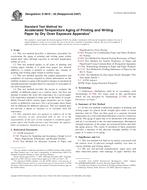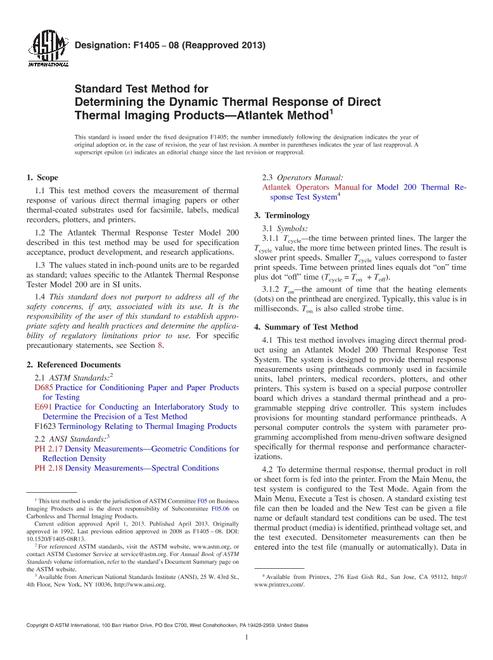This standard is issued under the fixed designation D ; the number mended. 1 These test methods are under the jurisdiction of ASTM Committee D06 on. ASTM D is an antifungal test method that provides a qualitative determination of fungal (mildew) resistance of paperboard, particularly those types which. Test, ASTM D Description. Standard Test Methods for Mildew (Fungus) Resistance of Paper and Paperboard. Sample retention time – 1 week.

| Author: | Malataxe Goktilar |
| Country: | Bhutan |
| Language: | English (Spanish) |
| Genre: | Politics |
| Published (Last): | 9 January 2009 |
| Pages: | 146 |
| PDF File Size: | 19.99 Mb |
| ePub File Size: | 15.96 Mb |
| ISBN: | 521-8-29123-121-8 |
| Downloads: | 77838 |
| Price: | Free* [*Free Regsitration Required] |
| Uploader: | Moogur |
Fungi may also degrade man-made polymer additives such as plasticizers, cellulosics, lubricants, stabilizers and colorants contained in organic coatings and plastics and other building products. They are microscopic fungi growing as single cells and do little damage to building products as their main source of carbon is obtained from hexose sugars such as glucose and fructose, or disaccharides such as sucrose and maltose. Sixty species of Aspergillus are encountered in human pathology.
Untreated sample piece is set up as a baseline control. Weekly photographic images of each sample are emailed to customers so they can follow the progress of the testing.
Testing – International Antimicrobial Council
The Basidiomycota Phylum contains 25, species of saprophytic mushrooms which obtain nutrients from decaying organic matter. This e2020 deteriorates plastics and paint and may present a problem in adhesive degradation.
When testing a treated product for antimicrobial performance the IAC seeks to provide useful reports to the members submitting the articles to be tested. Testing Microbiological aatm to qualify and quantify antimicrobial performance. The ASTM D standard is for fungal growth in soil, contained in the humidified environmental chamber. Trichoderma virens ATCCformerly Gliocladium virens, is chosen from the 32 species of Trichoderma as it is adapted to thrive in diverse situations and is a soil fungus capable of inducing soft rot in wood.
This method covers the qualitative determination of mildew fungus resistance of paper and paperboard, particularly for antifungal treated materials. Aspergillus niger ATCC is chosen from the species of V2020 as this species grows well on nutrient-depleted environments.

Treated Product Testing Antimicrobial efficacy testing is performed using a variety of recognized test standards. Antimicrobial Textiles For Fungi. The test Standards call for specific fungi to be used for resistance testing. The IAC laboratory has extensive experience in defining the appropriate test method based on the mode of action of the antimicrobial and the product being treated. Non-standard sample size depending on specific requirement of sponsor can be customized.
IAC representatives also work closely with its members and various standards organizations to refine and improve existing test standards and promote the adoption of newly developed test methods to help meet this objective.
For a Quote or any clarification, Contact Us now! An uninoculated treated sample control is set up to check for presence of native fungi which may be present on the sample. The 1, species of yeasts belong to this phylum also. The fungal spores may grow on the sample only if they are capable of extracting organic carbon from the sample. The IAC uses standard test standards but also customizes existing test methods to meet the needs of its members so that the testing correlates to the use and abuse conditions that their treated products will be exposed to in the real world.
Penicillium pinophilum ATCCformerly Aastm funiculosum, is a fungus that deteriorates plastics. These enzymes degrade complex biopolymers such as starch, cellulose and lignin into simpler substances which can be absorbed by the hyphae.
Bioassays pH Simulation studies. In recent years, the marketplace has been inundated with fungal resistant coatings and products designed to inhibit fungal growth. Antimicrobial Hard Surfaces For Bacteria.

Therefore, no organic carbon nutrients are available. This three-month exposure inside the environmental chamber exposes building materials to bacterial and mold attack. The specimens in the environmental chamber are thus surrounded with heavy fungal growth in each petri dish for 28 days to test for antifungal activity and leaching of the anti-fungal components into the PDA agar.
Shubhda Research Institute Unit No. Utilizing the appropriate test method for a given antimicrobial and substrate is important to obtaining consistent and reproducible results that correlate to the real world use of the treated product.
ASTM D2020 – Antifungal Paper Test
Disinfectants And Sanitizers Testing. The Zygomycota Phylum contains species, including bread mold. Shubhda Research Institute offers hands-on practical training programs at different levels addressing specific industries so as to aztm your skills and techniques.
Mildew and Rot Resistance of Textile Materials. Other Trichoderma species produce industrial enzymes such as cellulose, hemicellulase, xylanase and chitinase in bioreactors. This information allows the IAC laboratory to apply the correct test method and generate a test report that will provide the information requested. The following standards have been published for testing of materials for resistance to fungi: Fungi grow in the form of multicellular filaments called hyphae.